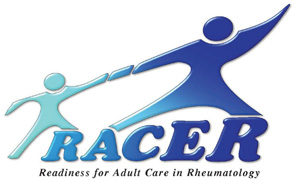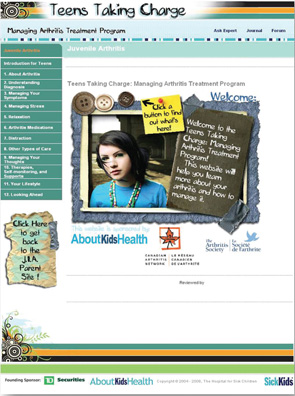
Image Credit: jps/shutterstock.com
Dr. Sheffield is an adult rheumatologist who received the following referral request from a family doctor: “Please see this 22-year-old male with a history of juvenile arthritis for ongoing care. I have only seen him once, and have no previous medical records.”
Dr. Sheffield meets with Paul, who reports that he has had arthritis since he was a young boy. He used a lot of different medicines, but isn’t sure of their names; his mother is in the waiting room and can provide details. He’s pretty sure he was referred to an adult rheumatologist when he turned 18, but he lost the doctor’s name and number, he was never called about an appointment, and things got busy at work and school. He hasn’t taken medicine for the past few years, because they’re really expensive, and he’s been feeling pretty good. Over the past few months, it’s gotten harder to walk, bend and climb stairs, so his mother got him into a family doctor, who sent him here.
Transitioning from the pediatric to adult healthcare system can present young patients with significant hurdles. The above vignette highlights some of the issues that may arise. This article focuses on transitional care in patients with juvenile idiopathic arthritis (JIA). It discusses some of the challenges for patients, families and healthcare providers (HCPs), and outlines some of the initiatives developed to address these challenges.
Definition of Transition
Transition is defined as “the purposeful, planned movement of adolescents and young adults with chronic physical and medical conditions from child-centered to adult-oriented healthcare systems.”1 It’s not an event that occurs at one point in time (e.g., transfer); it’s a gradual process that requires the acquisition of different skills from adolescence into the mid-20s, with the attainment of skills likely occurring in parallel with maturation of the frontal lobes.2
Transition Challenges for Youth & Parents
There is evidence that failure to transition successfully can adversely affect long-term health outcomes.3 A Canadian study showed that 52% of JIA patients had an unsuccessful transfer to, and/or sustained follow-up with, an adult rheumatologist.4 Depending on the location, institution and local administrative policies, youth are typically transferred to adult HCPs between the ages of 16 and 22. This is a particularly vulnerable time for youth. They are often preoccupied by body image, family, peer and sexual relationships, school and recreational activities. Health concerns are frequently relegated to the back burner, particularly if parents have assumed a managerial role for medical care. Youth may engage in high-risk behaviors that further contribute to poor transition outcomes. Studies show a high incidence of poor adherence, inadequate knowledge about disease and treatments, and poor advocacy skills at the time of transfer.5

The Readiness for Adult Care in Rheumatology (RACER) questionnaire is designed to measure transition readiness.
Youth and their parents often have a number of concerns about moving on to adult care. Pediatric centers are family centered. The interaction is informal and relaxed, parents are regarded as expert partners, and many centers have a multidisciplinary team, with rehabilitation and psychosocial support. Parents who have played an active role in managing their child’s health worry that they will be sidelined by adult HCPs and that their children are incapable of assuming responsibility for their medical condition. Patients and families often feel they are being abandoned by a healthcare team that has followed them, in some cases, since early childhood. They worry about starting over with a new HCP who doesn’t know their history. Changes or lapses in insurance coverage may lead to gaps in therapy. Unprepared patients may avoid making the first appointment.
Pediatric centers are family centered. The interaction is informal & relaxed, parents are regarded as expert partners, & many centers have a multidisciplinary team, with rehabilitation & psychosocial support.
Transition Challenges for HCPs
Adult centers are patient focused, with an expectation that patients manage their health autonomously. The interaction is more formal and business like, and it is less common to have the support of a multidisciplinary team. Adult HCPs may have limited knowledge of pediatric rheumatic diseases and an insufficient understanding of adolescent development. They are often frustrated with youth who don’t take responsibility for their health, parents who are overbearing and overly involved, and medical records that are inadequate or nonexistent.
Unique Features of JIA
When caring for adults with JIA, it’s important to recognize that JIA has unique features that distinguish it from adult RA. Chronic inflammation of the immature skeleton can cause growth disturbances, including short stature and limb length discrepancies, particularly in the lower extremities. Several prospective studies show that up to 75% of JIA patients have associated temporomandibular joint (TMJ) arthritis.6,7 Uncontrolled TMJ inflammation can cause microretrognathia, jaw asymmetry, pain and compromised function, including difficulty chewing and speaking. Chronic asymptomatic anterior uveitis, seen in up to 25% of JIA patients, can lead to development of irreversible scarring, glaucoma, cataracts and loss of vision.8

The Internet is a major resource for health information and is ideal for
providing healthcare services for young patients transitioning to adult care.
JIA Outcomes
Although few good long-term outcome studies exist and most don’t reflect treatment with biologics, data from North American and European centers show that between 40 and 70% of young adults with JIA will have persistent active arthritis.9-17 JIA patients have been shown to have functional limitations, lower employment rates and impaired quality of life.18-21 More than half of patients with uveitis will have persistent eye inflammation in adulthood.22 Because a significant number of JIA patients will require ongoing care by adult healthcare providers, it’s critical that youth be provided with developmentally appropriate skills that will allow them to transition and move on to the adult health system in a timely fashion.
Timing for Transition Interventions
Transition needs to start early. Data from the UK, U.S. and Canada support starting transitional care between the ages of 12 and 14.5,23-25 Youth should be trained with respect to self-management, self-advocacy and assertiveness. They should acquire knowledge about their medical condition and its treatment, and understand how their condition can affect recreational activities, vocational and educational plans, sexuality, reproduction and independent living. Although transitional care should be youth centered, parents are a key resource of support and knowledge for young people and should be included in the process.23
Obstacles for Transition Programs
A number of transition programs have been developed for youth with rheumatic conditions. These include education initiatives directed at teens during routine clinic visits, and dedicated transition clinics staffed by specialists that may include adolescent medicine, pediatric and adult rheumatology experts. There can be considerable obstacles to teaching transition skills, including geographic barriers, particularly for youth living in rural or remote areas, language barriers, and lengthy wait times to access services. In addition, there can be significant costs for families, including therapy-associated expenses, and absences from school and work.
Social Media & Transition
Social media can be a valuable tool to help overcome some of these obstacles. The Internet has become a major resource for health information and is a powerful mode of communication for youth, making it ideally suited to provide online healthcare services to this population.

Image Caption: carballo/shutterstock.com
Our group, as part of a national multicenter initiative, has developed an interactive Internet-based program, called Teens Taking Charge: Managing Arthritis Online (TTC, see image on opposite page). It’s designed for youth with JIA and their parents. Available in English, French and Spanish, it has multiple components, including JIA-specific education, self-management and coping strategies, social support and a parent site. This dynamic program keeps teens engaged with quizzes, interactive questions and goal-setting exercises. A pilot study supported the feasibility and initial efficacy of TTC for improving disease-specific knowledge and reducing pain in youth with JIA.26 Final evaluation for the effectiveness of this intervention is reaching completion, and the site should be freely available within the year.
Our center has also developed an online peer support intervention for youth with JIA, called Virtual Peer-to-Peer Mentoring (VP2P). We developed a support manual, provided training for mentors (i.e., young adults with JIA) and are completing a pilot study in which trained mentors connect with JIA teens using Skype. Preliminary results suggest the VP2P intervention is a promising psychosocial program with the potential to improve self-efficacy, self-management, disease knowledge and social support.
Adult HCPs … are often frustrated with youth who don’t take responsibility for their health, parents who are overbearing & overly involved, & medical records that are inadequate or nonexistent.
Measuring Transition Readiness
Although it’s important to assess the effectiveness of existing interventional programs, no validated tools exist to measure transition readiness in youth.27 As part of a national multicenter collaborative effort, our group developed the RACER questionnaire (Readiness for Adult CarE in Rheumatology) to measure transition readiness. The RACER questionnaire was designed to assess gaps in youths’ knowledge and emotional preparedness, identify areas in which they need additional education and support and assess the efficacy of transition interventions.28 We have completed testing of the RACER questionnaire for face and content validity, and will be testing construct validity and reliability.
Summary
It’s important to recognize that transfer to adult care often occurs at a time when youth don’t have the skills, emotional development or maturity to successfully make the move from the pediatric to the adult healthcare system. Poor transition can lead to adverse outcomes in long-term health management. Transition support and education will help. We are hopeful that ongoing research will lead to the development of innovative programs and tools to help ensure a successful transition.
 Lynn R. Spiegel, MD, FRCPC, is a rheumatologist in the Department of Paediatrics, The Hospital for Sick Children, and assistant professor in the Department of Paediatrics, University of Toronto, Ontario, Canada.
Lynn R. Spiegel, MD, FRCPC, is a rheumatologist in the Department of Paediatrics, The Hospital for Sick Children, and assistant professor in the Department of Paediatrics, University of Toronto, Ontario, Canada.
References
- Blum RW, Garell D, Hodgman CH, et al. Transition from child-centered to adult health-care systems for adolescents with chronic conditions. A position paper of the Society for Adolescent Medicine. J Adolesc Health. 1993 Nov;14(7):570–576.
- Shaw P, Kabani NJ, Lerch JP, et al. Neurodevelopmental trajectories of the human cerebral cortex. J Neurosci. 2008 Apr 2;28(14):3586–3594.
- Prior M, McManus M, White P, et al. Measuring the ‘triple aim’ in transition care: A systematic review. Pediatrics. 2014 Dec;134(6):e1648–1661.
- Hazel E, Zhang X, Duffy CM, et al. High rates of unsuccessful transfer to adult care among young adults with juvenile idiopathic arthritis. Pediatr Rheumatol Online J. 2010 Jan 11;8:2.
- Tucker L, Cabral DA. Transition of the adolescent patient with rheumatic disease: Issues to consider. Pediatr Clin North Am. 2005 Apr;52(2):641–652, viii.
- Muller L, Kellenberger CJ, Cannizzaro E, et al. Early diagnosis of temporomandibular joint involvement in juvenile idiopathic arthritis: A pilot study comparing clinical examination and ultrasound to magnetic resonance imaging. Rheumatology (Oxford). 2009 June;48(6):680–685.
- Weiss PF, Arabshahi B, Johnson A, et al. High prevalence of temporomandibular joint arthritis at disease onset in children with juvenile idiopathic arthritis, as detected by magnetic resonance imaging but not by ultrasound. Arthritis Rheum. 2008 Apr;58(4):1189–1196.
- Foster CS. Diagnosis and treatment of juvenile idiopathic arthritis-associated uveitis. Curr Opin Ophthalmol. 2003 Dec;14(6):395–398.
- Peterson LS, Mason T, Nelson AM, et al. Psychosocial outcomes and health status of adults who have had juvenile rheumatoid arthritis: A controlled, population-based study. Arthritis Rheum. 1997 Dec;40(12):2235–2240.
- Ruperto N, Ravelli A, Levinson JE, et al. Long-term health outcomes and quality of life in American and Italian inception cohorts of patients with juvenile rheumatoid arthritis. II. Early predictors of outcome. J Rheumatol. 1997;24(5):952–958.
- Zak M, Pedersen FK. Juvenile chronic arthritis into adulthood: A long-term follow-up study. Rheumatology (Oxford). 2000 Feb;39(2):198–204.
- Oen K. Comparative epidemiology of the rheumatic diseases in children. Curr Opin Rheumatol. 2000 Sep;12(5):410–414.
- Minden K, Niewerth M, Listing J, et al. Long-term outcome in patients with juvenile idiopathic arthritis. Arthritis Rheum. 2002 Sep;46(9):2392–2401.
- Flato B, Lien G, Smerdel A, et al. Prognostic factors in juvenile rheumatoid arthritis: A case-control study revealing early predictors and outcome after 14.9 years. J Rheumatol. 2003 Feb;30(2):386–393.
- Fantini F, Gerloni V, Gattinara M, et al. Remission in juvenile chronic arthritis: A cohort study of 683 consecutive cases with a mean 10 year followup. J Rheumatol. 2003 Mar;30(3):579–584.
- Foster HE, Marshall N, Myers A, et al. Outcome in adults with juvenile idiopathic arthritis: A quality of life study. Arthritis Rheum. 2003 Mar;48(3):767–775.
- Nordal E, Zak M, Aalto K, et al. Ongoing disease activity and changing categories in a long-term nordic cohort study of juvenile idiopathic arthritis. Arthritis Rheum. 2011 Sep;63(9):2809–2818.
- Packham JC, Hall MA. Long-term follow-up of 246 adults with juvenile idiopathic arthritis: Functional outcome. Rheumatology (Oxford). 2002 Dec;41(12):1428–1435.
- Packham JC, Hall MA. Long-term follow-up of 246 adults with juvenile idiopathic arthritis: Education and employment. Rheumatology (Oxford). 2002 Dec;41(12):1436–1439.
- Packham JC, Hall MA. Long-term follow-up of 246 adults with juvenile idiopathic arthritis: Social function, relationships and sexual activity. Rheumatology (Oxford). 2002 Dec;41(12):1440–1443.
- Packham JC, Hall MA, Pimm TJ. Long-term follow-up of 246 adults with juvenile idiopathic arthritis: Predictive factors for mood and pain. Rheumatology (Oxford). 2002 Dec;41(12):1444–1449.
- Kotaniemi K, Arkela-Kautiainen M, Haapasaari J, et al. Uveitis in young adults with juvenile idiopathic arthritis: A clinical evaluation of 123 patients. Ann Rheum Dis. 2005 Jun;64(6):871–874.
- McDonagh JE. Young people first, juvenile idiopathic arthritis second: Transitional care in rheumatology. Arthritis Rheum. 2008 Aug 15;59(8):1162–1170.
- Hait E, Arnold JH, Fishman LN. Educate, communicate, anticipate-practical recommendations for transitioning adolescents with IBD to adult healthcare. Inflamm Bowel Dis. 2006 Jan;12(1):70–73.
- Wolf-Branigin M, Schuyler V, White P. Improving quality of life and career attitudes of youth with disabilities: Experiences from the Adolescent Employment Readiness Center. Res Soc Work Pract. 2007;17(324).
- Stinson JN, McGrath PJ, Hodnett ED, et al. An Internet-based self-management program with telephone support for adolescents with arthritis: A pilot randomized controlled trial. J Rheumatol. 2010 Sep;37(9):1944–1952.
- Stinson J, Kohut SA, Spiegel L, et al. A systematic review of transition readiness and transfer satisfaction measures for adolescents with chronic illness. Int J Adolesc Med Health. 2014;26(2):159–174.
- Stinson J, Spiegel L, Duffy KW, et al. Development and testing of the readiness for adult care in rheumatology (RACER) questionnaire for adolescents with rheumatic conditions. Ann Rheum Dis. 2012;71(Suppl 3).


